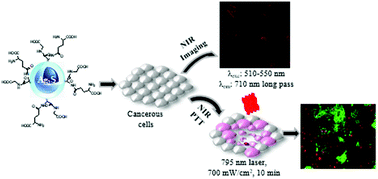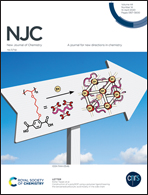Ag2S-Glutathione quantum dots for NIR image guided photothermal therapy†
Abstract
Aqueous synthesis of glutathione (GSH) coated Ag2S quantum dots (QD) with strong emission in the medical imaging window (700–900 nm) was performed from AgNO3. Variations in temperature, time, pH and sulfur source (Na2S and thioacetamide) were studied to tune the emission wavelength and intensity of the QDs. The optimum synthesis conditions to produce the smallest QDs (ca. 7 nm) with the highest quantum yield (70%) and excellent stability were determined as 50 °C and pH 10 where Na2S was used in 2 h reactions. The cytotoxicity was evaluated with MTT assay on the HT29 and MCF7 cancer cell lines and indicated no significant toxicity of the QDs up to 200 μg mL−1. The Photothermal Therapy (PTT) potential was first investigated using a 795 nm, continuous-wave fiber coupled diode laser using aqueous solutions of QDs and then on HT29 and MCF7 cells. QD (150 μg mL−1) treated MCF7 cells almost quantitatively died after 10 min irradiation at 795 nm (700 mW, 1.82 W cm−2) and the viability of HT29 cells dropped to 40%. Most cell death was late apoptotic/necrotic. This study indicates that such a laser irradiation procedure and the QDs are safe, yet their combination provides dramatic cell death upon short laser treatment. PTT coupled with strong intracellular optical signal promotes Ag2S-GSH QDs as potential theranostic nanoparticles.



 Please wait while we load your content...
Please wait while we load your content...